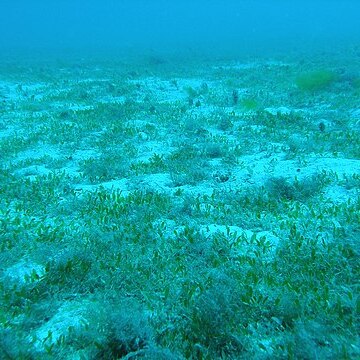Monoecious.. Roots 1 per node.. Rhizome narrowly terete, unbranched, 0.1–0.4 mm. in diameter, whitish or greenish.. Erect stems 1–10 mm. long.. Leaves in pairs, 1 pair on each erect stem; blade elliptic to oblong-elliptic, 10–21 mm. long, 4.5–8 mm. wide, obtuse or rounded at apex, cuneate at base, often sparsely pubescent, rarely glabrous, somewhat translucent, light to mid-green, rarely dark green, with 2 of the parallel veins often running up to 0.5 mm. below the margin, connected by 6–9 pairs of cross-veins ascending at an angle of 40–70°; margins serrulate; petiole up to 15 mm. long.. Stipules obovate to suborbicular, 0.35–4 mm. long, 0.3–2.8 mm. wide, obtuse or rounded, keeled, sparsely pubescent on keel, greenish or whitish.. Spathe-bracts ovate, 2.5–4.1 mm. long, ± 1.5 mm. wide, acuminate, keeled, whitish, translucent, containing 1 ♂ and 1 ♀ flower.. Male flowers: pedicel up to 3 mm. long; tepals elliptic to ovate, 0.3–1 mm. long, ± 0.5 mm. wide, obtuse, spreading, whitish; anthers ± 1 mm. long; filaments up to 4 mm. long.. Female flowers: ovary of 3 carpels, ovoid, 1 mm. long, perianth-tube 1–2 mm. long, the lower portion persisting as beak in fruit; styles 3; stigmas 3, ± 2.5 mm. long.. Fruit ellipsoid to subglobose, ± 2 mm. long, ± 1.8 mm. wide, with beak up to 2 mm. long, whitish.. Seeds up to 30, ovoid, 0.2 mm. long, light green or light brown.
Monoecious. Stems thin, easily breaking, with 1 root at the nodes, internodes 1-4.5 cm. Scales transparent, scarious, obovate, doubled, keeled, 3-7 mm, outside hairy, apex incised, base amplexi-caulous. Leaves oblong-elliptic, obtuse or rounded, cuneate at the base, green, at one or both sides faintly covered with short, rigid, unicellular hairs, very fine-serrulate, 10-23 by 3-6 mm, only 1 pair on a 1-10 mm long shoot; cross-nerves 6-9 pairs, ascending, joining the intramarginal nerve; midrib united at the top with the intramarginal nerves running at c. 0.5 mm distance from the margin; petiole 3-15 mm, triquetrous. Spathe ovate, acuminate, keeled, scarious, transparent, 3-4 mm, at the margin ciliate, at the keel with fine serrulate teeth, at the outside hairy or not, tearing at the top as the fruit is ripening, containing 1 male and 1 female flower, spathe segment enclosing the female flower embracing the other. Male flower: perianth segments oblong-elliptic to ovate, obtuse, convex, 1-1.5 mm long; anthers c. 1 mm, pollen grains elliptic; pedicel 3 mm; after anthesis the complete flower with its pedicel caducous. Female flower subsessile; ovary ovate, 1 mm, beak 1-2 mm; styles 3, 2.5 mm. Fruit broad-elliptic, 2.5 by 1.5 mm; beak 1.5-2 mm; pericarp scarious, transparent. Seeds c. 30, ovate, 0.2 mm.
Marine to estuarine, submerged, monoecious, annual or perennial herb. Rhizome fleshy, c. 1 mm diam.; scales usually hairy. Leaves with petiole distinctly shorter than blade; blade oblong-elliptic, 10–25 mm long, 2.5–6.5 mm wide, finely serrulate, obtuse to acute, membranous, hairy or sometimes glabrous; cross veins in 5–9 pairs, unforked. Spathal bracts hairy, enclosing a male and a female flower. Male flowers with pedicel to 25 mm long; tepals ovate to elliptic, 2 mm long; anthers linear-oblong, 1.5–2 mm long. Female flowers sessile on rhizome nodes; hypanthium 1–2 mm long; tepals minute; ovary ovoid, 1 mm long; styles 3, 1.5–2.5 mm long. Fruit ellipsoid, 2–5 mm diam. Seeds c. 30, ovoid, 0.2–0.5 mm diam.; testa reticulate.
Rhizomes with 2 scales at each node. Erect stems absent. Leaves apparently attached to rhizome, 10--25 ´ 3--6 mm; blade oblong-elliptic, base cuneate, margins serrulate, apex obtuse to rounded, pubescent. Inflorescences: spathe enclosing both staminate and pistillate flowers. Flowers unisexual, staminate and pistillate on same plants; staminate flowers deciduous shortly after anthesis; pistillate flowers nearly sessile, 2 mm. Fruits ovoid. Seeds ca. 0.2 mm.
Creeping stems with internodes 1-3.2 cm; scales membranous, transparent. Petiole 1-2 cm; leaf blade oblong-elliptic, 10-22 × 3-7 mm, midvein prominent, with 1 diverging pair of intramarginal veins at base, with 6-9 pairs of cross veins. Plants monoecious. Spathes ovate, 3-3.5 mm, with abaxial hairs. Ovary ca. 1.4 mm; styles short, ca. 2 mm; stigmas 3. Fruit globose, ca. 2.5 × 1.5 mm. Seeds 10-15(-30), globose, 0.4-0.6 mm.


